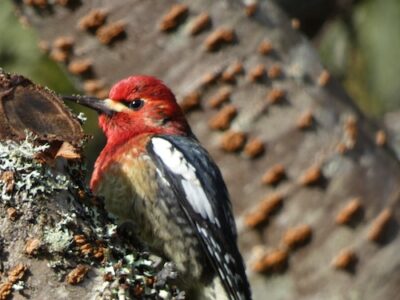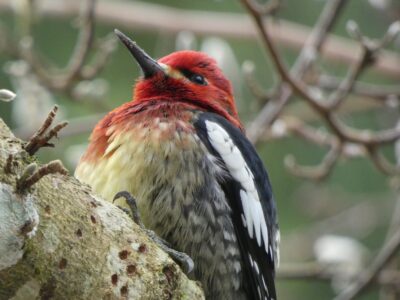Article and photos by Tim Twiford
The red-breasted sapsucker is much more than just a tree artist with his precise patterns tapped into both coniferous and deciduous trees. (In our yard, they go for the sap of the cherry and magnolia, which I think would be sweeter than that of a pine or cedar, but my lips stuck together in the midst of research so I’m not quite certain.) They are also a keystone species, and as a keystone species they create food for many other species, i.e. birds, small mammals and insects. An example is the rufous hummingbird who nests close to the sapsucker’s nest and follows him around for fresh sap in the spring before flowers begin to bloom. Some come for the sap, others for the insects drawn to the sap, while predators lay close for those who show up.

The size of a robin, the red-breasted sapsucker has a short life span, three years on average. The longest ever recorded was five. You may think (if you’ve ever seen one at work) that this could be due to banging his beak repeatedly into a tree, brain-clanging back and forth like a bell clapper, up to 20 times per second! But not so. As usual, mother nature’s “biological engineering department” has come up with an amazing design.
Woodpeckers have an upper and a lower eyelid just like we do, but they also have a third eyelid called the nictitating membrane (as do sharks and reptiles) which opens and closes horizontally. This membrane keeps the flying wood particles from getting into the eyes and wipes them clean as it opens and closes. It also acts like a seatbelt for the brain. Behind the beak the woodpecker has a mass of bone and muscle that functions much like an airbag to mitigate impact. (This all sounds like a Volvo ad to me!) Plus, with a stiff tail and two toes pointing forward, and two pointing backward for stability, the woodpecker family is built to pound away!
Another bioengineering marvel is the woodpecker family’s specialized tongue. Their tongues need to be longer than their beaks to reach into a sap well and slurp up the sap. (Fun fact: a gathering of sapsuckers is called a “slurp,” and no I didn’t make that up, John!). However, it can’t just hang out of the beak constantly running into things. So, the woodpecker’s tongue wraps around a series of bones in the jaw and up over the head (think retractable hose reel). To extract the sap, the front of the tongue has hair-like bristles that act much like a bottle brush.
 I thought feeding time with infant twins was tough, but the feeding of four to seven little sapsuckers is not for the lazy or easily distracted. In the first six days of life, the babies are fed every seven minutes. Not every seven hours, but every seven minutes! While both parents share equally in this exhaustive duty, I’ve done the math: 1,440 (the number of minutes in a day), divided by seven minutes equals a number not divisible by two, so who gets the extra shift? As it turns out, neighboring red-breasted adults without a brood pitch in to help.
I thought feeding time with infant twins was tough, but the feeding of four to seven little sapsuckers is not for the lazy or easily distracted. In the first six days of life, the babies are fed every seven minutes. Not every seven hours, but every seven minutes! While both parents share equally in this exhaustive duty, I’ve done the math: 1,440 (the number of minutes in a day), divided by seven minutes equals a number not divisible by two, so who gets the extra shift? As it turns out, neighboring red-breasted adults without a brood pitch in to help.
Finally, contrary to popular belief, red-breasted sapsuckers rarely kill a tree. The tree seals the holes fairly quickly, and unless you experience a “slurp” (also uncommon), these beautiful “food trucks of the forest” are definitely beneficial residents.



